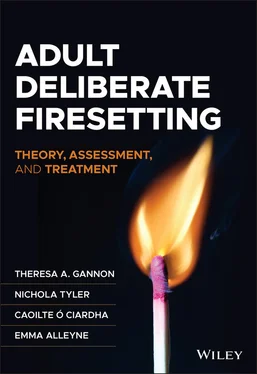Theresa A. Gannon - Adult Deliberate Firesetting
Здесь есть возможность читать онлайн «Theresa A. Gannon - Adult Deliberate Firesetting» — ознакомительный отрывок электронной книги совершенно бесплатно, а после прочтения отрывка купить полную версию. В некоторых случаях можно слушать аудио, скачать через торрент в формате fb2 и присутствует краткое содержание. Жанр: unrecognised, на английском языке. Описание произведения, (предисловие) а так же отзывы посетителей доступны на портале библиотеки ЛибКат.
- Название:Adult Deliberate Firesetting
- Автор:
- Жанр:
- Год:неизвестен
- ISBN:нет данных
- Рейтинг книги:5 / 5. Голосов: 1
-
Избранное:Добавить в избранное
- Отзывы:
-
Ваша оценка:
- 100
- 1
- 2
- 3
- 4
- 5
Adult Deliberate Firesetting: краткое содержание, описание и аннотация
Предлагаем к чтению аннотацию, описание, краткое содержание или предисловие (зависит от того, что написал сам автор книги «Adult Deliberate Firesetting»). Если вы не нашли необходимую информацию о книге — напишите в комментариях, мы постараемся отыскать её.
Explore the theoretical foundations of—and discover effective treatment options for—adults who deliberately set fires Adult Deliberate Firesetting: Theory, Assessment, and Treatment,
Adult Deliberate Firesetting: Theory, Assessment, and Treatment
Adult Deliberate Firesetting — читать онлайн ознакомительный отрывок
Ниже представлен текст книги, разбитый по страницам. Система сохранения места последней прочитанной страницы, позволяет с удобством читать онлайн бесплатно книгу «Adult Deliberate Firesetting», без необходимости каждый раз заново искать на чём Вы остановились. Поставьте закладку, и сможете в любой момент перейти на страницу, на которой закончили чтение.
Интервал:
Закладка:
Concluding Remarks
This book consolidates the research evidence into a practical guide to inform the assessment and treatment of adults who set fires. Evidence-based practice is the ultimate goal. However, admittedly, many elements of this book are evidence-informed (Bonta & Andrews, 2017) rather than evidence-based. As discussed in this chapter and further interrogated throughout this book, the research literature is yet to be saturated with clinical trials and/or quasi-experimental research designs evaluating varying methods to assess risk and reduce reoffending. Nonetheless, existing theories and research do provide sufficient steer for clinicians to make informed judgements.
Note
1 1If firesetting rates were not reported per 100,000 in the sources we cite, we calculated this rate based on the reported firesetting statistic relative to the approximate population size in the relevant year. Doing so allowed us to report prevalence of firesetting in a standardised way across studies or sources.
2 Key Characteristics and Clinical Features of Individuals Who Set Deliberate Fires
Describing the characteristics of who sets fires will not be particularly informative unless we begin by noting two important considerations. First, there is no one personality or psychopathology that defines individuals who set fires. These individuals are heterogeneous in their characteristics, offending histories, and motives for setting fires. Second, consideration of the factors that differentiate people who engage in criminal firesetting (i.e., apprehended or non-apprehended) from people in the general population who have not engaged in criminal behaviour differs from consideration of the factors that differentiate people who have engaged in criminal firesetting from other justice-involved individuals who have not set fires. This distinction is important. If people who set fires are indistinguishable—psychologically speaking—from the general population, then practitioners have no treatment targets to address in prevention or treatment initiatives. If individuals apprehended for firesetting are indistinguishable from other justice-involved individuals, then treatments need not be tailored for firesetting. This chapter examines the key demographic, developmental, psychopathological, and psychological features of individuals who have set fires. A key aim of this chapter is to highlight (1) the key clinical features that appear to differentiate those who have set deliberate fires from the wider population and (2) the key clinical features that differentiate individuals apprehended for firesetting from other justice-involved individuals.
When considering the characteristics of any offending population, it is worth considering why we are interested in these characteristics. First, establishing what sets our focal population apart from the rest of the population may provide indirect evidence of the causal chains that have led to the offending behaviour. The observation of differences between groups provides a starting point for hypothesising about the causal relationships between background or psychological factors and offending behaviours like firesetting. Second, examining group differences in characteristics helps us to determine which factors are statistically related to increased risk of offending or re-offending and thus improves decisions about the prioritisation of individuals for treatment as well as public protection decisions about release and supervision. A third reason why we are interested in the characteristics of offending populations is to determine which factors may be targets for treatment.
A key consideration when examining and presenting information on the characteristics of adults who set fires is the quality of evidence available. The most useful evidence for the characteristics of this population would come from high-quality sources, ideally cohort studies, representative large sample studies, well-powered studies with matched comparison groups, or meta-analyses. Unfortunately, these types of sources are rare in the study of adult firesetting due to the relative recency of sustained research on the topic.
Characteristics of Adults Who Set Fires
Sociodemographic Findings
Men appear more likely to engage in deliberate firesetting than females. Examination of a nationally representative US sample including participants self-reporting lifetime firesetting (including juvenile firesetting) suggested that for every woman reporting deliberate firesetting, there were almost five men (the National Epidemiologic Survey on Alcohol and Related Conditions [NESARC] dataset; Blanco et al., 2010; Hoertel et al., 2011; Vaughn et al., 2010). A study of all individuals convicted of arson in Sweden over a 12-year period indicated that approximately four men were convicted of arson for every woman (Anwar et al., 2011). The gender difference was slightly larger in a study of all individuals convicted of arson in a 9-year period in a single Australian state, with over six men convicted for every woman (Ducat et al., 2017). Dickens and Sugarman (2012) suggested that women may be more likely to be diverted from the criminal justice system or referred to psychiatric services. Some psychiatric samples appear to evidence this latter point. For example, Enayati et al. (2008) reported three men for every woman in their study of all individuals convicted of arson and sent for psychiatric assessment over a four-year period in Sweden. While men appear to set deliberate fires at a higher rate than women, women appear to account for a higher proportion of those convicted of firesetting than they do of people convicted of other offences (Ducat et al., 2013a). To date, research appears only to have examined firesetting and gender using a male–female dichotomy.
There is little clear evidence that ethnicity meaningfully intersects with whether people set fires. Using nationally representative self-reported US data, lifetime firesetting was reported less frequently by Black, Hispanic, and Asian participants than by non-Hispanic white participants (Blanco et al., 2010). However, this dataset (the NESARC study; see also Hoertel et al., 2011; Vaughn et al., 2010) is one of few sources of prevalence statistics using nationally representative data. Another US representative study of adolescents also indicated that self-reported firesetting was more common among white participants than participants of other ethnicities (Chen et al., 2003). However, the dearth of comparable non-US literature presents a challenge in generalising any ethnicity difference in self-reported firesetting prevalence to other jurisdictions. Dickens and Sugarman (2012) concluded that the ethnicity of individuals who set fires in existing clinical studies is broadly comparable to the population from which they are drawn. For example, Gannon (2010) suggested that women who set fires were characterised by white ethnicity. However, this was consistent with individuals apprehended for other offences in the small sample studies she relied on and likely matched the general population in those jurisdictions.
The population of apprehended adults who set fires appear to be more likely than non–justice-involved individuals to experience greater socioeconomic disadvantage and have lower educational attainment, as well as lower rates of skilled employment (for a review, see Gannon & Pina, 2010). Based on a small number of studies that compared people who set fires to other apprehended individuals, individuals with a history of firesetting appear to have lower attainment in terms of education (Räsänen et al., 1995) and employment (Ducat et al., 2013a; Räsänen et al., 1995). However, when we look at the NESARC data on self-reported firesetting in the US population, it appears that individuals who had set fires were not characterised by sociodemographic differences compared with the wider community (Blanco et al., 2010; Vaughn et al., 2010). Split by gender (Hoertel et al., 2011), these same data suggest that men who set fires had higher levels of education on average than those who had not set fires. Across three UK studies, Barrowcliffe and Gannon (2015, 2016; Gannon & Barrowcliffe, 2012) found no clear evidence of sociodemographic differences between individuals reporting firesetting for which they had not been apprehended and people who did not report firesetting.
Читать дальшеИнтервал:
Закладка:
Похожие книги на «Adult Deliberate Firesetting»
Представляем Вашему вниманию похожие книги на «Adult Deliberate Firesetting» списком для выбора. Мы отобрали схожую по названию и смыслу литературу в надежде предоставить читателям больше вариантов отыскать новые, интересные, ещё непрочитанные произведения.
Обсуждение, отзывы о книге «Adult Deliberate Firesetting» и просто собственные мнения читателей. Оставьте ваши комментарии, напишите, что Вы думаете о произведении, его смысле или главных героях. Укажите что конкретно понравилось, а что нет, и почему Вы так считаете.












